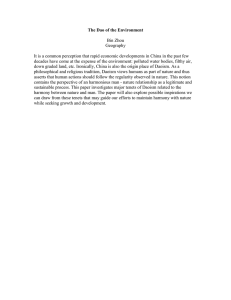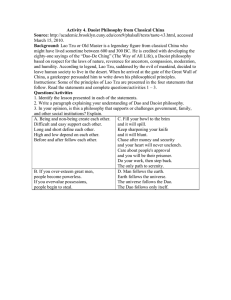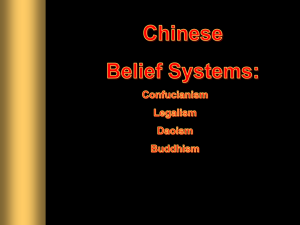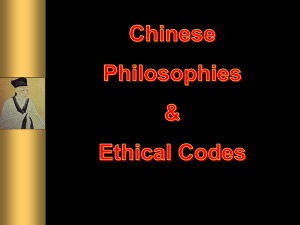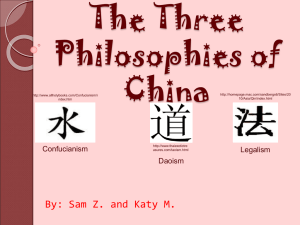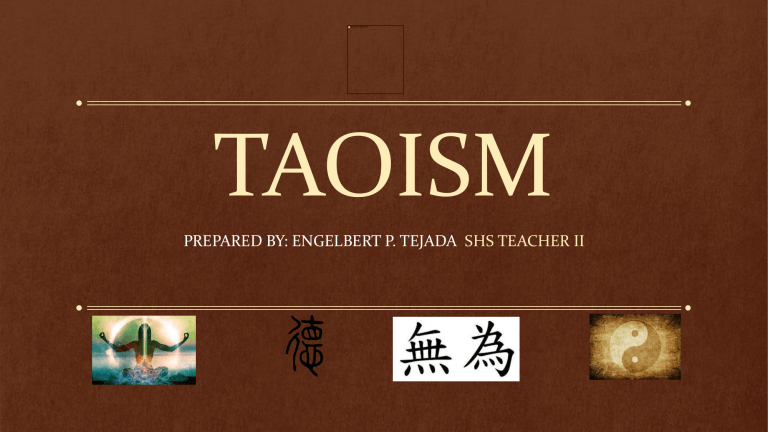
TAOISM PREPARED BY: ENGELBERT P. TEJADA SHS TEACHER II Reminder: Please observe minimum health protocols. REVIEW OF THE PAST LESSON 1. What is the basis of the Teachings and beliefs of Confucianism? 2. How should a person live according to the book: Doctrine of the Mean? 3. What are the five Cardinal Relations in Confucianism? Learning Objectives: 1. Trace the historical background of Daoism; 2. Explain the core teachings, fundamental beliefs, practices, and related issues of Daoism; 3. Appreciate Daoism as a philosophy and religion. 1.JUMBLE SOLVER! Answer: TAOISM ITOMSA A nature-based philosophy and religion that flourished in China during the late Bronze Age and became an official religion during the Tang Dynasty 2.JUMBLE SOLVER! Answer: Yin-Yang INYNYGA It is one of the most famous symbols represented in Taoism. The meaning behind the symbol is that the colors, black and white, are complementary forces (rather than opposing forces) 3. JUMBLE SOLVER! Answer: LAO ZI OLIZA According to the myth, he was conceived by a shooting star and was born of a virgin mother, who kept him in her womb for 82 years. 4. JUMBLE SOLVER! Answer: CHI HIC It refers to the natural energy or life force that sustains living beings 5. JUMBLE SOLVER! Answer: EXORCISM MEXOCRSI A ritual performed in cases of sickness with the goal of gaining victory over the evil spirits. I. Historical Background Daoism is a nature-based philosophy authored and founded by Lao Tzu (c.500 BCE). The focal idea of Daoism is the relationship of human beings and the nature. Daoist believe that everything comes from the Dao (The Way). Human nature should be aligned with the rest of the nature to achieve harmony and balance. Self cultivation should be encouraged for Daoist to return to the natural mode of existence. Historical Background The ultimate goal of Daoists was to conform to the great pattern of nature, which is called Dao, or “The Way.” As a philosophy, Daoism focuses on the great mysteries of the Dao; as a religion, its goal is to achieve long life and, ultimately, immortality. LAO-TZU (LAO ZI) 5th or 6th Century BC The name “Lao Tzu,” in the world of learning, also means “old master” or “old scholar.” According to the Myth, Laozi was conceived by a shooting star and was born of a virgin mother, who kept him in her womb for 82 years; he was said to be born with flowing hair, which signifies that he would become a wise man. Zhuangzi (Chuang Tzu) 369-286 BCE According to Sima Qian, his last name was Chuang, his given name was Chou, and Tzu means “master,” thus Chuang Tzu (Zhuangzi) means “Master Chuang.” He was born in the town of Meng in a small state of Sung, near the border between present-day Hunan and Shandong Province. Zhuangzi is considered a great philosopher and a great writer, and he wrote a book, together with his followers, which became known as Zhuangzi, and was believed to be completed before the HanDynasty. (Fairbank and Reischauer 1989) II. SACRED TEXT OF TAOISM • Dao De Jing (Tao Te Ching)-Daoism’s foundational text, meaning “The Book of the Way and its Power”. This short book of around 5,000 Chinese characters is divided into 81 brief chapters filled with short, enigmatic paragraphs of advice on life, and poetic descriptions of the nature of the universe. Taoists regard the Tao te Ching as the essential guide to living a full spiritual and ethical life. • Book of Chuang Tzu-Written during the third century B.C.E. and attributed to a man named Zhuangzi, the second founder of Daoism. It consists of delightful parables, metaphors, and poetic passages, and is praised for its high literary value which represents the most significant formulation of early Daoist thought. III. Concepts, Beliefs, Doctrines and Practices 1. The Dao- The Tao (or Dao) is hard to define but is sometimes understood as the way of the universe. The Dao is distinct from God. It is not a being for it is the origin of all beings. 2. Deity/God (Dao as the Origin of all Beings)-Daoism does not have a God unlike other religions in the world. However, the Dao itself is not God and is not worshipped by the Daoists. Instead, they worship deities, who are gods of a particular role, and they traditionally worship Lao Tzu not only as the first god of Daoism but also as the representation of the Dao. The Three “Pure One” A. “Jade Pure One” or the “Primeval Lord of the Heaven” (Yuanshi Tianzun).He is believed to be residing in the Heaven of Jade Purity. He is described as eternal, limitless, without form, the source of everything, and the administrator of Heaven. He is the highest Taoist deity. B. “Supreme Pure One” or “Lord of the Numinous Treasure” (Lingbao Tianzun). He is associated with the principle of yin and yang, and is considered the source of Taoist knowledge and scripture (the Tao Te Ching). C. “Grand Pure One” or “Lord of the Way and its Virtue” (Daode Tianzun). He is believed to have been manifested or incarnated in the form of Lao Tzu. He is depicted as having pure white beard, symbolizing his being an eminent, aged ruler. III. Concepts, Beliefs, Doctrines and Practices 3. Yin- Yang-The Yin-Yang (meaning “shady side” and “sunny side”) is one of the most famous symbols represented in Taoism. The meaning behind the symbol is that the colors, black and white, are complementary forces (rather than opposing forces). 4. The De- means virtue or the proper adherence to Dao. It refers to the power to bring the Tao into realization. 5. Wu Wie- Wu-Wei means “no behaviour” or “doing nothing.” It also means “to do without doing” or “actionless activity.” 6. Qi/Chi- Chi is the force that sets the world and everything in it into motion. The qi refers to the natural energy or life force that sustains living beings. Qi literally means “air’ or “vapor.” IV. Worship and Observances Exorcism- performed in cases of sickness with the goal of gaining victory over the evil spirits. Chiao (jiao) - is a cosmic renewal which is made up of several small rituals. A shortened version of this ritual requires the local villagers to present offerings to the deities, to bring peace and prosperity to the village. IV. Worship and Observances Exorcism Chiao (jiao) IV. Worship and Observances A. Meditative Practices Daoist sage exemplifies the virtue of humility. The sage also manifests the virtue of non-competition by not competing but emerging victorious nonetheless. B. Moral Practices - Daoists tend not to initiate action; instead they wait for events to make action necessary, avoiding letting their own desires and compulsions push them into doing things. Generally, Daoism, just like other religions, disapprove of killing, stealing, lying, and promiscuity. It promotes philanthropic, selfless, and humane behaviour. Good behaviour is seen as an essential part not only of selfimprovement but the world as a whole. IV. Worship and Observances Goal Practices To attain use of potions (led to the practice of alchemical experiments which made longevity and lasting contributions in various fields such as chemistry, medicine, and immortality pharmacology) practice meditation (includes experiments with one’s self, especially the body through the use of methods of inner alchemy, associated with yoga and other forms of meditation) breathing technique (to be in contact with qi, for longevity and to counter aging. To dispel - Jiao Festival (or the rite of cosmic renewal, celebrated to rededicate thee illness or local temple and to renew the whole community by cleansing it from suffering suffering and hardships. - Refrain from eating grain (based on the Daoist belief that illness is caused by three corpse worms which reside in the body and eating grain will encourage these worms to stay. - Confession and purging of one’s sin (based on the belief that illness may be caused by wrongdoings) V. SELECTED ISSUES A. Fatalism - Daoism has been criticized for propagating laziness or espousing a fatalistic attitude in life by letting nature take its course and reminding Daoist to just go with the flow. B. Superstition - There is a misconception that Daoism involves sorcery, which includes the drawing of signs, chants, and other practices which led to the notion that Daoism promotes superstitious practices. C. Urban Development - Environmentalism is one issue confronted by Daoism. Daoists believe in the dictum “leave nature alone and nature will thrive.” Thank you!
